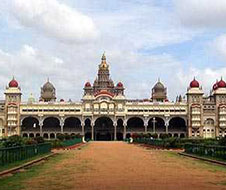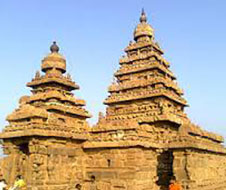mahabalipuram
mahabalipuram

Mamallapuram, also known as Mahabalipuram, is a town in Kancheepuram district in the Indian state of Tamil Nadu, around 60 km south of the city of Chennai. It is an ancient historic town and was a bustling seaport during the time of Periplus (1st century CE) and Ptolemy (140 CE), from where ancient Indian traders sailed to countries of South East Asia.By the 7th century it was a port city of the South Indian dynasty of the Pallavas.
Mahabalipuram, is a town in Kancheepuram district in the Indian state of Tamil Nadu, around 60 km south of the city of Chennai. It is an ancient historic town and was a bustling seaport during the time of Periplus (1st century CE) and Ptolemy (140 CE), from where ancient Indian traders sailed to countries of South East Asia.By the 7th century it was a port city of the South Indian dynasty of the Pallavas. It has a group of sanctuaries carved out of rock in the 7th and 8th centuries: rathas (temples in the form of chariots), mandapas (cave sanctuaries), giant open-air rock reliefs such as the famous Descent of the Ganges, and the Shore Temple, with thousands of sculptures to the glory of Shiva. The Group of Monuments at Mahabalipuram has been classified as a UNESCO World Heritage Site.
About mahabalipuram
The temples of Mahabalipuram, portraying events described in the Mahabharata, were built largely during the reigns of Narasimhavarman and his successor Rajasimhavarman and show the movement from rock-cut architecture to structural building. The city of Mahabalipuram was largely developed by the Pallava king Narasimhavarman I in the 7th century AD.The mandapa or pavilions and the rathas or shrines shaped as temple chariots are hewn from the granite rock face, while the famed Shore Temple, erected half a century later, is built from dressed stone. What makes Mahabalipuram so culturally resonant are the influences it absorbs and disseminates. The Shore Temple includes many reliefs, including one 100 ft. long and 45 ft. high, carved out of granite.
Sight Seeing Places

The Shore Temple (built in 700-728 AD) is so named because it overlooks the shore of the Bay of Bengal. It is a structural temple, built with blocks of granite, dating from the 8th century AD. It was built on a promontory sticking out into the Bay of Bengal at Mahabalipuram, a village south of Chennai in the state of Tamil Nadu in India. At the time of its creation, the village was a busy port during the reign of Narasimhavarman II of the Pallava dynasty.As one of the Group of Monuments at Mahabalipuram, it has been classified as a UNESCO World Heritage Site since 1984.It is one of the oldest structural (versus rock-cut) stone temples of South India.

Pancha Rathas
Pancha Rathas (also known as Pandava Rathas) is amonument complex at Mahabalipuram, on the Coromandel Coast of the Bay of Bengal, in the Kancheepuram district of the state of Tamil Nadu, India. Pancha Rathas is an example of monolithic Indian rock-cut architecture. Dating from the late 7th century, it is attributed to the reign of King Mahendravarman I and his son Narasimhavarman I (630-680 AD; also called Mamalla, or "great warrior") of the Pallava Kingdom. An innovation of Narasimhavarman, the structures are without any precedent in Indian architecture. The complex is under the auspices of the Archaeological Survey of India (ASI) and is part of the UNESCO World Heritage site inscribed by UNESCO as Group of Monuments at Mahabalipuram.

Descent of the Ganges is a monument at Mahabalipuram, on the Coromandel Coast of the Bay of Bengal, in the Kancheepuram district of the state of Tamil Nadu, India. Measuring 96 by 43 feet, it is a giant open-air rock relief carved on two monolithic rock boulders. The legend depicted in the bas-relief is the story of the descent of the sacred river Ganges to earth from the heavens led by Bhagiratha. The waters of the Ganges are believed to possess supernatural powers. The descent of the Ganges and Arjuna's Penance are portrayed in stone at the Pallava heritage site.The relief is more of a canvas of Indian rock cut sculpture at its best not seen anywhere in India.It is one of the Group of Monuments at Mahabalipuram that were designated as a UNESCO World Heritage Site since 1984.

Varaha Cave Temple (also Adivaraha Cave Temple) is a rock-cut cave temple located at Mamallapuram, on the Coromandel Coast of the Bay of Bengal in Kancheepuram District in Tamil Nadu, India. It is part of the hill top village, which is 4 kilometres (2.5 mi) to the north of the main Mahabalipurm sites of rathas and the Shore Temple.It is an example of Indian rock-cut architecture dating from the late 7th century. The temple is one of the finest testimonial to the ancient Vishwakarma Sthapathis, of rock-cur cave architecture, out of many such caves also called mandapas. Part of the Group of Monuments at Mahabalipuram, the temple is a UNESCO World Heritage Site as inscribed in 1984 under criteria i, ii, iii and iv.The most prominent sculpture in the cave is that of Lord Vishnu in the incarnated form of a Varaha or boar lifting Bhudevi, the mother earth goddess from the sea. Also carved are many mythical figures.
Accomidation
how to reach
By Rail : Chennai central station is near to Mahabalipuram which is connected with major cities lika Banglore,Hyderabad,Tirupati.
Distances From Banglore:
Banglore: 350km
Chennai: 55 km
Pondicehery: 99 km
By Air : Chennai International Airport is the major airport nearby. Chennai is about 55 km away from Mahabalipuram and it is 2 hour drive from chennai.Chennai is well connected to most of the major airports in India and abroad..
Online Enquiry & Payment Confirmation
- Pls Submit and click Proceed For Payment Button to proceed Online Transfer
- Further To help Contact on mobile @9845370515
